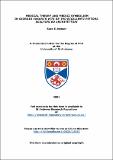Files in this item
Medical theory and Medici symbolism in Giorgio Vasari's "Vite de' più eccellenti pittori, scultori ed architettori"
Item metadata
| dc.contributor.advisor | Smith, Graham | |
| dc.contributor.author | Nestor, Sara E. | |
| dc.coverage.spatial | xiii, 280 p. | en_US |
| dc.date.accessioned | 2017-11-10T16:42:11Z | |
| dc.date.available | 2017-11-10T16:42:11Z | |
| dc.date.issued | 2001 | |
| dc.identifier.uri | https://hdl.handle.net/10023/12053 | |
| dc.description.abstract | When Giorgio Vasari wrote the 'Vite de'piu eccellenti pittori, scultori ed architettori', the intended audience of his text not only included the artists of his own time, but also involved his Medici patrons. Indeed, the book was dedicated to Cosimo I de'Medici. The 'Vite' were thus intended as a guide for artists and as a means of paying homage to Vasari's patron. The quest for artistic perfection, through knowledge, was united with courtly principles and iconography, resulting in the raising of the status of the arts above the level of the mechanical. This was most resolutely achieved through the analysis of medicine, and in particular, the theory of the four humours, which not only governed medical practice, but also were of astrological and philosophical significance. While Vasari's vocabulary drew upon the symbolism of the Medici, who were born under the planet of Saturn, which also governed the melancholy humour, his discussion of the diseases suffered by artists was based upon the sciences of Hippocrates, Aristotle, Galen and Avicenna and were mainly caused by melancholy. Vasari's text also provided the melancholic with his cure, most notably at the Company of the Cazzuola. Here, the artists and their Medici patrons could find repose and amusement. Entertainments were based upon those of the court and included theatrical performances and banqueting. However, medical knowledge was also of practical significance to the painter and the sculptor. It provided a guide to the internal workings of man and thus, the external appearance of disease in the human body. The alteration in human appearance, as a symptom of disease was fully noted by Vasari in his physiognomic descriptions of the artists' appearances caused by temperament, character and disease and finally, found inclusion in the teachings of the Accademia del Disegno of which Giorgio Vasari had been a founding member. | en_US |
| dc.language.iso | en | en_US |
| dc.publisher | University of St Andrews | |
| dc.subject.lcc | N6922.V2N3 | |
| dc.subject.lcsh | Vasari, Giorgio, 1511-1574. Vite de' più eccellenti architetti, pittori et scultori italiani | |
| dc.title | Medical theory and Medici symbolism in Giorgio Vasari's "Vite de' più eccellenti pittori, scultori ed architettori" | en_US |
| dc.type | Thesis | en_US |
| dc.type.qualificationlevel | Doctoral | en_US |
| dc.type.qualificationname | PhD Doctor of Philosophy | en_US |
| dc.publisher.institution | The University of St Andrews | en_US |
This item appears in the following Collection(s)
Items in the St Andrews Research Repository are protected by copyright, with all rights reserved, unless otherwise indicated.

